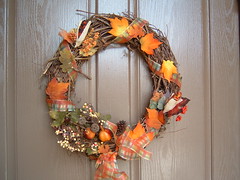Decorations on the front door are the first impressions you give to guests throughout the holidays. There are a lot of people who display a simple wreath or pine branches even before
Thanksgiving weekend. It's easy to make a mood and feeling with anything from a couple of branches of greens tied using a bow to a very ornately adorned wreath. To make your own wreath, you'll find the frames and all the fixings in a well-supplied garden center. Here are a few ideas you might pick up on.
Simply Stated
Bundle branches of winterberry and white pine and tie them together using raffia or a red ribbon having gold edges.
A Welcome Garland
Dried flowers of all types are available at garden centers and can from time to time be found in the supermarket. It's easy to handcraft a garland from pink straw flowers, wheat, lemon leaves, cockscomb, bay leaves, lavender, rosebuds, and moss. Put this to the front door or hang it on the fireplace mantel. To create a garland you'll need: heavy grade string cut to required length of garland, florist's tie wire, florist's picks, clippers, sprigs of greenery, green florist's tape, and decorative accessories like pods, berries,
pinecones, and dried fruit.
1. Cut a bundle of greens about ten inches long. Hold them against the twine then wrap with florist's tape.
2. Keep on adding and wrapping greens so each bundle overlaps the previous stems.
3. Tie some wire to the pinecones and attach. Use the picks to set berries and small bunches of dried flowers. Push the picks under the green tape.
Cinnamon Bundle
Use long cinnamon sticks and pink pepperberry to make a bundle the size of a small log. Wrap jute around the center to hold them together, then hang on the door for a fragrant and simple decor.
Simply Stated
Tie a couple of pine branches together using wire and wrap with wide, taffeta ribbon, kook for ribbon that has wired edges. Deep hunter green or burgundy ribbon edged with gold is ideal. Make a fat bow. The wire edges would keep the shape of the bow intact. Cut the ends of the ribbons a bit long to have two streamers. Ruffle them into soft ripples hanging down over the pine needles. You might want to add a few small golden glass balls spread out on the pine branches for a lovely, elegant door decoration.
For the Birds
Make use of a straw ring frame to form the base of your wreath. You will need florist's wire and clippers to bind twigs and branches, a raffia bow, small birdhouse, artificial birds, bundles of birdseed covered in gauze, and a bird's nest inserted into the twigs and branches. Fill with birdseed if you wish to draw in the birds.
For the Cook
To create this simple door decoration, accumulate a bunch of fragrant sprigs of bay leaves, rosemary, and pepper berries and tie using raffia for hanging. If you don't have an overhang or your front door is not protected, consider using this decoration to hang in your kitchen alternatively.
Fruity and Fancy
Start with a balsam fir wreath. Add up bits and pieces of bark, twigs, slices of fruit, nuts, and leaves. You'll find these in craft stores and garden centers, if not around your own home. Secure them using florist's wire or a hot glue gun. Add a red plaid flannel bow for a different touch.
Seashell Wreath
You could use whatever shells for this one, but deep blue mussel shells achieve the prettiest simple wreath. Use a Bristol board or flat Styrofoam wreath frame and hot-glue the mussel shells in concentric pattern around the wreath. Furnish a simple bow fashioned from netting, or leave as it is.
Brass Band
If you have a brass knocker on your front door, apply it as part of your wreath decoration. Wire tiny golden balls to an evergreen wreath and place it on the door putting the knocker in the center.
Woodland Wreath
Start out using a fir wreath from the garden shop and make it more interesting via wiring boughs of eucalyptus, long needle pines, and cedar throughout. Add a wired white organdy bow to exquisitely top if off.
Personalized Wreath
It's easy to personalize a wreath with wooden letters. These are available in craft stores together with different wooden shapes like candy canes, stockings, stars, trees, and hearts. Paint them with bright colors and hot-glue them around a wreath frame. The letters could spell out your family name or the names of your children.
Hydrangeas
In New England, the hydrangea bushes are wonderful for wreath-making. Depending on the soil, the blossoms could be deep or pale blue, yellowish green, pale pink, or deep cranberry. These round fat bundles of blossoms are fixed to a straw or foam wreath frame with florist pins so they are bunched up and blanket the frame. This is a wreath for indoors because moisture would destroy it. Provide a bow in a color to match the flowers and you'll have one of the prettiest displays for your windows or hall.
Ribbon Wreath
Make a wreath entirely from ribbons for your entryway. You'll need a ten-inch heavy wire or brass ring and a fifty-yard spool of half-inch decorative ribbon. Cut the ribbon into ten-inch lengths and tie-up each length into a bow on the ring. Fill the ring with bows bunched up so the wreath is quite full. Keep on tying bows on the ring till you can no longer fit any more and the wreath is pleasingly plump.
Golden Greetings
© 2011 Athena Goodlight



































